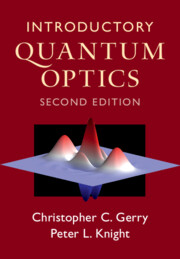124 results
Bridging the great divide: Conspiracy theory research for the 21st century
-
- Article
-
- You have access
- HTML
- Export citation

Introductory Quantum Optics
-
- Published online:
- 14 December 2023
- Print publication:
- 30 November 2023
-
- Textbook
- Export citation
Copyright page
-
- Book:
- Introductory Quantum Optics
- Published online:
- 14 December 2023
- Print publication:
- 30 November 2023, pp iv-iv
-
- Chapter
- Export citation
11 - Applications of Entanglement: Heisenberg-Limited Interferometry and Quantum Information Processing
-
- Book:
- Introductory Quantum Optics
- Published online:
- 14 December 2023
- Print publication:
- 30 November 2023, pp 338-385
-
- Chapter
- Export citation
5 - Quantum Coherence Functions
-
- Book:
- Introductory Quantum Optics
- Published online:
- 14 December 2023
- Print publication:
- 30 November 2023, pp 134-154
-
- Chapter
- Export citation
Brief Contents
-
- Book:
- Introductory Quantum Optics
- Published online:
- 14 December 2023
- Print publication:
- 30 November 2023, pp vii-viii
-
- Chapter
- Export citation
4 - Emission and Absorption of Radiation by Atoms
-
- Book:
- Introductory Quantum Optics
- Published online:
- 14 December 2023
- Print publication:
- 30 November 2023, pp 89-133
-
- Chapter
- Export citation
1 - Introduction
-
- Book:
- Introductory Quantum Optics
- Published online:
- 14 December 2023
- Print publication:
- 30 November 2023, pp 1-10
-
- Chapter
- Export citation
Index
-
- Book:
- Introductory Quantum Optics
- Published online:
- 14 December 2023
- Print publication:
- 30 November 2023, pp 408-414
-
- Chapter
- Export citation
3 - Coherent States
-
- Book:
- Introductory Quantum Optics
- Published online:
- 14 December 2023
- Print publication:
- 30 November 2023, pp 50-88
-
- Chapter
- Export citation
6 - Beam Splitters and Interferometers
-
- Book:
- Introductory Quantum Optics
- Published online:
- 14 December 2023
- Print publication:
- 30 November 2023, pp 155-190
-
- Chapter
- Export citation
Appendix A - The Density Operator, Entangled States, the Schmidt Decomposition, and the Von Neumann Entropy
-
- Book:
- Introductory Quantum Optics
- Published online:
- 14 December 2023
- Print publication:
- 30 November 2023, pp 386-397
-
- Chapter
- Export citation
Appendix D - Nonlinear Optics and Spontaneous Parametric Down-Conversion
-
- Book:
- Introductory Quantum Optics
- Published online:
- 14 December 2023
- Print publication:
- 30 November 2023, pp 406-407
-
- Chapter
- Export citation
Reviews
-
- Book:
- Introductory Quantum Optics
- Published online:
- 14 December 2023
- Print publication:
- 30 November 2023, pp ii-ii
-
- Chapter
- Export citation
Appendix B - Quantum Measurement Theory in a (Very Small) Nutshell
-
- Book:
- Introductory Quantum Optics
- Published online:
- 14 December 2023
- Print publication:
- 30 November 2023, pp 398-401
-
- Chapter
- Export citation
Appendices
-
- Book:
- Introductory Quantum Optics
- Published online:
- 14 December 2023
- Print publication:
- 30 November 2023, pp 386-407
-
- Chapter
- Export citation
8 - Dissipative Interactions and Decoherence
-
- Book:
- Introductory Quantum Optics
- Published online:
- 14 December 2023
- Print publication:
- 30 November 2023, pp 257-279
-
- Chapter
- Export citation
Contents
-
- Book:
- Introductory Quantum Optics
- Published online:
- 14 December 2023
- Print publication:
- 30 November 2023, pp ix-xii
-
- Chapter
- Export citation
10 - Experiments in Cavity QED and with Trapped Ions
-
- Book:
- Introductory Quantum Optics
- Published online:
- 14 December 2023
- Print publication:
- 30 November 2023, pp 308-337
-
- Chapter
- Export citation
Appendix C - Derivation of the Effective Hamiltonian for Dispersive (Far Off-Resonant) Interactions
-
- Book:
- Introductory Quantum Optics
- Published online:
- 14 December 2023
- Print publication:
- 30 November 2023, pp 402-405
-
- Chapter
- Export citation

